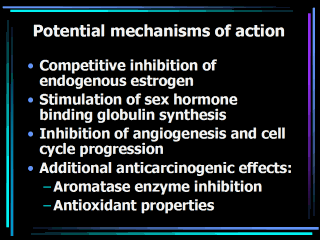 |
The estrogen-like structure of phytoestrogens enables them
to bind to estrogen receptors in humans. They have been shown to bind to
both ER alpha as well as ER beta, but have a higher affinity for ER beta.
The phytoestrogens are weaker than endogenous estrogens and can exhibit both
estrogenic and antiestrogenic effects depending on the individualís amount
of circulating endogenous estrogens and the type and number of estrogen
receptors in the target tissue. For example, brain and bone tend to have
higher numbers of ER beta. On the other hand, although they are relatively
weak estrogens, they are generally present in the body in much greater
amounts than are the endogenous estrogens. Another hormonal effect is the
stimulation of sex hormone binding globulin synthesis. Higher amounts of
SHBG increases the chances that endogenous estrogen will be bound and less
bioavailable to target tissues. Hormonal effects are not the only mechanism
by which phytoestrogens can act. Other mechanisms by which phytoestrogens
could affect carcinogenesis include inhibition of angiogenesis and cell
cycle progression, aromatase enzyme inhibition, and antioxidant effects. |
